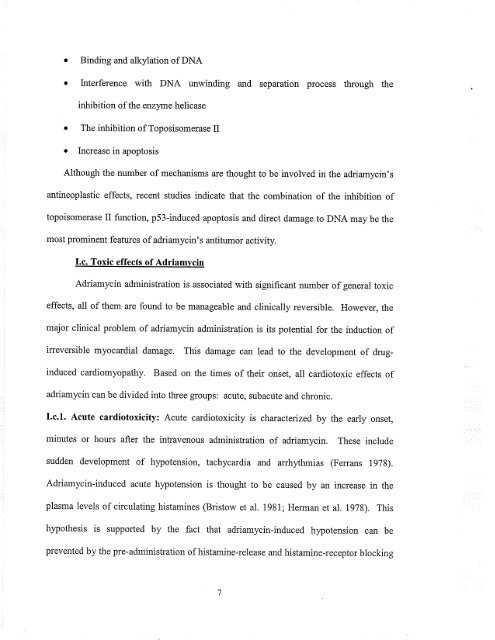il\VOLVEMENT OF RETII\OIC ACID II{ - MSpace at the University of ...
il\VOLVEMENT OF RETII\OIC ACID II{ - MSpace at the University of ...
il\VOLVEMENT OF RETII\OIC ACID II{ - MSpace at the University of ...
You also want an ePaper? Increase the reach of your titles
YUMPU automatically turns print PDFs into web optimized ePapers that Google loves.
Binding and alkyl<strong>at</strong>ion <strong>of</strong> DNA<br />
Interference with DNA unwinding and separ<strong>at</strong>ion process through <strong>the</strong><br />
inhibition <strong>of</strong> <strong>the</strong> enzyme helicase<br />
The inhibition <strong>of</strong> Toposisomerase <strong>II</strong><br />
o Increase in apoptosis<br />
Although <strong>the</strong> number <strong>of</strong> mechanisms are thought to be involved in <strong>the</strong> adriamycin's<br />
antineoplastic effects, recent studies indic<strong>at</strong>e th<strong>at</strong> <strong>the</strong> combin<strong>at</strong>ion <strong>of</strong> <strong>the</strong> inhibition <strong>of</strong><br />
topoisomerase <strong>II</strong> function, p53-induced apoptosis and direct damage to DNA may be <strong>the</strong><br />
most prominent fe<strong>at</strong>ures <strong>of</strong> adriamycin's antitumor activity.<br />
I.c. Toxic effects <strong>of</strong> Adriamvcin<br />
Adriamycin administr<strong>at</strong>ion is associ<strong>at</strong>ed with significant number <strong>of</strong> general toxic<br />
effects, all <strong>of</strong> <strong>the</strong>m are found to be manageable and clinically reversible. However, <strong>the</strong><br />
major clinical problem <strong>of</strong> adriamycin administr<strong>at</strong>ion is its potential for <strong>the</strong> induction <strong>of</strong><br />
irreversible myocardial damage. This damage can lead to <strong>the</strong> development <strong>of</strong> druginduced<br />
cardiomyop<strong>at</strong>hy. Based on <strong>the</strong> times <strong>of</strong> <strong>the</strong>ir onset, all cardiotoxic effects <strong>of</strong><br />
adriamycin can be divided into three groups: acute, subacute and chronic.<br />
I.c.l. Acute cardiotoxicity: Acute cardiotoxicity is characteized by <strong>the</strong> early onset,<br />
minutes or hours after <strong>the</strong> intravenous administr<strong>at</strong>ion <strong>of</strong> adriamycin. These include<br />
sudden developrnent <strong>of</strong> hypotension, tachycardia and arrhythmias (Ferrans lg78).<br />
Adriamycin-induced acute hypotension is thought to be caused by an increase in <strong>the</strong><br />
plasma levels <strong>of</strong> circul<strong>at</strong>ing histamines (Bristow et al. 1981; Herman et al. 1978). This<br />
hypo<strong>the</strong>sis is supported by <strong>the</strong> fact th<strong>at</strong> adriamycin-induced hypotension can be<br />
prevented by <strong>the</strong> pre-administr<strong>at</strong>ion <strong>of</strong> histamine-release and histamine-receptor blocking







![an unusual bacterial isolate from in partial fulf]lment for the ... - MSpace](https://img.yumpu.com/21942008/1/190x245/an-unusual-bacterial-isolate-from-in-partial-fulflment-for-the-mspace.jpg?quality=85)





![in partial fulfil]ment of the - MSpace - University of Manitoba](https://img.yumpu.com/21941988/1/190x245/in-partial-fulfilment-of-the-mspace-university-of-manitoba.jpg?quality=85)


